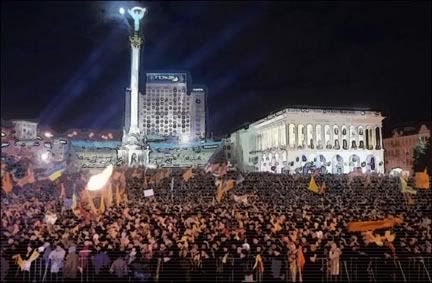Adam Larson
Caustic Logic/Guerillas Without Guns
Posted 4/7/07
Absent the binding force of Soviet-era political and military control, a power vacuum that Zbigniew Brzezinski called in 1997 “the black hole” hovered over the void, once Soviet, “middle space” in the “Grand Chessboard” of Eurasia. Russia was eventually bound to regain its regional power and at least some of its global reach, so Western efforts were stepped-up to politically and economically integrate more former SSRs along the path to Europe taken by the Baltic states. The window of opportunity could be only so long before Russia got its shoelaces untangled and started closing the West’s lead, but until then it was largely land-locked and ice-bound; the USSR had enjoyed direct access to ice-free ports in the Baltic and near-total domination of the Black Sea, its window onto the Mediterranean and world markets. Now it had lost most of its south Baltic ports (retaining the Kaliningrad exclave and of course St. Petersburg in the north) while access to the Black Sea relied on close relations with independent Ukraine, which took a joint role in managing the Black Sea Fleet and maintained a fluctuating relationship with Moscow.
Unlike the Baltic and Black Seas, the Caspian’s value for shipping is only local; its prime value lay in that its littoral basin held the remains of a vast inland sea that left behind widespread oil and natural gas deposits, known since the 1970s at the latest and used by the Soviet Union to add to its vast Siberian gas reserves. The Caspian’s oil supplies are moderate, but its supplies of natural gas are huge, believed to be about 250 trillion cubic feet or 5% of world total, and well-placed to help feed the growing energy demands of Europe, Russia, China, or India. Like the Black Sea, the Caspian basin was once nearly totally dominated by the USSR, but after 1991 was dominated by Iran and the independent nations of the Caucasus and Central Asia, with Russia only maintaining a decent toehold on the north shore, from which pipelines carry Russia’s share of oil and gas north, near the war-torn Muslim autonomous region of Chechnya. (Brzezinski, it must be noted, is the chaorman of the American Committee for Peace in Chechnya (ACPC), which calls itself “the only private, non-governmental organization in North America exclusively dedicated to promoting the peaceful resolution of the Russo-Chechen war.")
While the “black hole” and the Caspian’s promise beckoned Western interest in the 1990s, the Eurasian powers still had the clear advantage in Caspian export routes; Russia’s Soviet-era pipeline system provided the most established route to the vast markets of Europe. China had the possibility of eastbound landlines, if dauntingly long, mountainous, and set to feed in through its own Kosovo, Muslim-dominated Xinjiang. Southbound routes could feed markets in India, China, and all of East Asia by sea, most easily making their way to port and tanker via Iran. Indeed as the only nation with access to both Caspian and Persian Gulf supplies, Iran has among the world’s most developed pipeline systems, but so long as it was ruled by the Ayattolahs, Iran was not to be rewarded with Western investment.
Caspian export routes, existing and proposed. General contours of Russian-Iranian-Chinese-dominated systems vs. the American-led model.
So American and Western planners sought to get as much as possible of the fuels out right by China, Russia and Iran, and so looked in two directions for pipelines in open areas where they could muscle in on the action (see map). One direction is east and as south as possible, away from Russia and around Iran, with the ultimate target of markets in South and East Asia. The main problem with this route was that they would all of necessity cross Afghanistan, which was in the 1990s embroiled in civil war with no end in sight, and in 2007 much the same, although now with a solid US military boot in the door a favorble outcome seems possible - eventually.
The other main window of opportunity was due west across the Caucasus states of Azerbaijan and Georgia, the rocky alley between Russian and Iranian turf. These Caucasian pipelines could then connect via Turkey to the Mediterranean, to pipelines - running through the Balkans - into Europe and its vast energy markets. Other planned lines could snake beneath the Black Sea to enter Europe at Bulgaria, and flow west through Macedonia (split from Yugoslavia in 1991) and end on the Albanian coast.
(all this is covered in slightly greater depth here).


No comments:
Post a Comment